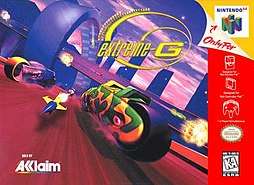Extreme-G
| Extreme-G | |
|---|---|
 | |
| Developer(s) | Probe Entertainment |
| Publisher(s) | Acclaim Entertainment |
| Composer(s) | Simon Robertson |
| Platform(s) | Nintendo 64 |
| Release |
|
| Genre(s) | Racing |
| Mode(s) | Single-player, multiplayer |
Extreme-G is a racing video game developed by Probe Entertainment and published by Acclaim Entertainment. It was released for the Nintendo 64 in 1997. A sequel, Extreme-G 2, was released in 1998.
Gameplay

The gameplay of Extreme-G consists mainly of fast-paced racing through an array of futuristic environments. An impressive array of defensive and offensive weapons are available on-track. These include multi-homing/reverse missiles, magnetic/laser mines, and shield-boosting power-ups. Special weapons can also be found such as invisibility, phosphorus flash and the mighty Wally-Warp which if not avoided, can instantly transport a bike right to the back of the pack.
As with all Extreme-G games, futuristic racing pilots race plasma-powered bikes in an intergalactic Grand Prix at speeds that are over 750 km/h making it the third fastest racing game on the Nintendo 64, only beaten by F-Zero X and Star Wars: Episode I Racer. The emphasis is on speed and creative racetrack design, with tracks looping through like roller coasters.
At the beginning of each round, the player is given three "nitro" powerups which provide a temporary speed boost (these powerups cannot be replenished). Also, falling off cliffs or, in some cases, the track itself results in simply losing time rather than losing 'lives'; bikes are teleported back to the track and must rebuild their speed and lost time from a dead standstill. Some parts of many tracks are shown to be hundreds of feet in the air.
The single player games come in three difficulty settings: Novice, Intermediate and Extreme. The main game mode (Extreme Contest) features three championships: Atomic (four tracks), Critical Mass (eight tracks) and Meltdown (full 12 standard tracks). The player must come first in each championship to progress. Winning championships on the various difficulty levels will open up the hidden bikes, levels and cheats. Once the levels have been opened they can be used for the additional single and multi-player modes.
Plot
Extreme-G is set in the distant future where Earth is reduced into a wasteland. From their new-found planet the human colonists watch their remote controlled bikes wreak havoc through their ancient cities and fight their way to determine which racer manages to qualify.
Development
Extreme-G was developed under the working title "Ultimate Racer".[1]
Reception
| Reception | ||||||||||||||||||||
|---|---|---|---|---|---|---|---|---|---|---|---|---|---|---|---|---|---|---|---|---|
| ||||||||||||||||||||
Extreme-G received generally positive reviews from critics.[3] Peer Schneider of IGN praised the game for its sense of speed, but admitted that it can often be "too fast for its own good".[7] Edge criticized the handling of the bikes, but highlighted the game's emphasis on combat.[4] Game Revolution praised the game's replay value due to the game's large number of tracks, weapons and multiplayer options.[5]
References
- ↑ "Gaming Gossip". Electronic Gaming Monthly. No. 93. Ziff Davis. April 1997. p. 28.
- ↑ "Extreme-G". GameRankings. Archived from the original on March 4, 2016. Retrieved August 22, 2018.
- 1 2 "Extreme-G". Metacritic. Archived from the original on April 25, 2017. Retrieved September 1, 2018.
- 1 2 "Extreme-G". Edge. No. 53. Future Publishing. Christmas 1997. p. 107.
- 1 2 Colin (November 1997). "Mommy, stop the ride, I wanna get off!!!". Game Revolution. Archived from the original on October 19, 2004. Retrieved October 19, 2004.
- ↑ Joe Fielder (October 30, 1997). "Extreme-G Review". GameSpot. Archived from the original on November 28, 2015. Retrieved August 22, 2018.
- 1 2 Peer Schneider (October 24, 1997). "Extreme-G". IGN. Archived from the original on March 4, 2016. Retrieved August 22, 2018.